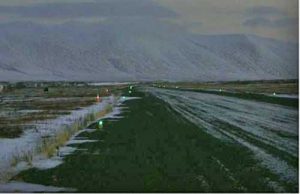
This winter a fire destroyed a public works building in Anaktuvuk Pass also destroying the electrical system that powers the runway’s lighting system. In the winter, no runway lights means no access to outside emergency medical care and medevacs during the long dark nights – a potentially dangerous situation.
The fire raged in the early morning hours between a Wednesday and Thursday in February. On Thursday morning, the Alaska Department of Military & Veteran Affairs contacted DOT&PF requesting emergency runway lighting. DOT&PF sprang into action coordinating with the North Slope Borough right away and by Friday evening, a set of DOT&PF emergency Landing Lights had been delivered to the village from Anchorage by Ryan Air with only ten minutes of daylight to spare. The next day, Rich Sewell, with DOT&PF Statewide Aviation arrived and conducted training on how to use the lights with about a dozen first responders and public works employees in the community.
This fast-moving and collaborative effort between DOT&PF, the North Slope Borough, DMVA, and the community of Anaktuvuk Pass prevented a potentially dangerous situation in a village where aviation is a lifeline. Anaktuvuk Pass, a village of 355 residents is located 250 miles northwest of Fairbanks in the Brooks Range. It is only accessible by air. The airport is owned by the North Slope Borough.[xyz-ihs snippet=”adsense-body-ad”]DOT&PF’s emergency runway lighting program grew out of an FAA “Study for the House and Senate Appropriations Committees” in May 2001 titled “Aviation Access to Remote Locations in Alaska.” FAA funded the research, development, and acquisition of the Emergency Landing Zone lights. The individual lights are battery powered and use a military grade light bulb that is compatible with nightvision goggles. Various lights were tested in cooperation with the U.S. Coast Guard. Originally there were 782 emergency lights purchased divided into full-runway lighting systems and helicopter landing lights.
Source: Plane Talk






